The Gift of South Dakota
Subscriptions to South Dakota Magazine make great gifts!
Subscribe today — 1 year (6 issues) is just $29!
Tragedy at Amsden Dam
Jul 25, 2012
Amsden Dam near Andover is a pretty little lake with humble roots. The 235 acre lake sits behind a Works Progress Administration dam. The dam was started in 1934, while South Dakota was in the grip of the Dust Bowl and the nation was mired in the Great Depression. Work was scarce and WPA jobs made it possible for the farmers of southwestern Day County to feed their families. The dam was completed in 1936 and the lake was full by 1937. The dam holds back water from Pickerel Creek and Mud Creek, both tributaries on their way to the Jim River. Lurking beneath the lake’s surface is an old gravel pit that provides its deepest holes — 27 feet. Those holes have provided Amsden with its most popular current use, muskie fishing, and its darkest day — less than one year after its birth.
The New Lake Held Hidden Dangers
In 1937 there weren’t community swimming pools, Red Cross swimming lessons or long road trips for entertainment. On August 15, Leo, a local farmer, and his wife Pearl, a country school teacher, gathered their 6 children and the rest of the Happy-Go-Lucky 4-H Sewing and Garden Club of Southeast Andover at their farm for their 4-H meeting. When the meeting was over, the kids begged Leo and another father, Herman Wenck, to take them to the new local lake to cool off. Pearl had lunch ready, but put it on hold for them to eat after a quick trip to Amsden. The group happily went down the hill for swimming and games on the southeastern shore. To the immediate west of the picnic area shore, hidden below the surface, were the now water-filled gravel pits.
Leo lived just up the hill from the dam and had worked on its construction. Because so few people had the opportunity in those times to learn to swim, Leo put a rock on the shoreline to mark a point that the bathers were not to venture past. Dilleen Ninke Wenck was 10 at the time and still remembers vividly the admonition: “Don’t go north of that rock.” The warning was needed because about ten feet out, and north from that point, the lake dropped off into the old gravel pit. As the day progressed the group enjoyed wading and playing waist-deep in Amsden — until an unusual event occurred, with fatal consequences.
False Teeth Led to Tragedy
Mrs. Simonson and her friend, Mrs. Miller, waded into the lake to cool their feet, near the forbidden limits. While leaning over, Mrs. Simonson lost her false teeth into the lake. As she searched about for them, she slipped into the gravel pit depths and began screaming for help. Leo, one of the few swimmers in the group, swam to her aid, but the screaming led to pandemonium. Family members focused on their screaming, drowning loved ones and not the warning about the pit ran to assist — and found themselves quickly in peril, thrashing in water over their heads. As the confusion and the tragedy unfolded, Leo swam and retrieved and swam and retrieved the neighbors thrashing in the lake. His youngest son Maynard, only 10, had an inflated inner tube that his older brother, Leo Jr., 16, swam out with to pull his father’s retrieves to shore. The news accounts of the day describe Leo as a “strong swimmer” and Leo Jr. as a “fair swimmer.” Sr. kept returning to the deep waters and retrieving bodies. Jr. split his time between pulling the saved to shore and punching others who were trying to get back into the water to help their screaming, drowning loved ones — and creating more work and danger for Jr.’s now tiring father. Helping Leo Jr. that day was his teenage friend, a non-swimmer, Orville Simonson.
But, in what seemed like just minutes, there was silence. The screaming from the lake stopped. Leo Jr looked about — his Dad was gone. As the families hugged and gathered, the magnitude of the tragedy was soon evident — five families would not go home from the picnic intact that day. Four bodies were recovered before the dragging equipment could arrive from Webster: Leo Sr. (age 36), Herman Wenck (age 42), Ruby Miller (age 12), and Mildred Simonson (age 13). That night a fifth body, Irene Wahl (age 13), was recovered, and the last, Mrs. Clarence Miller (age 42), the mother of deceased Ruby, was found floating across the lake the next day.
Leo Sr.’s body, clawed beyond recognition, was recovered with his last rescue effort wrapped around his head.
Leo Jr. was credited with saving a half dozen young 4-Hers that day. Dilleen Ninke Wenck was one of those children. She still recalls, just before she was pulled to safety, telling her father “Dad, I want to go with you,” and hearing her father’s last words, “You can’t go with me today,” as he slipped under the waves. Another of those children, Carolyn Schoenbeck Pooley, was 8 and recalls her father Leo’s last words being “Go to shore, Kelly” as he put her on the inner tube for Jr. to pull in, before swimming back out into the deep waters.
Lessons to Take Away from the Amsden Tragedy
There are lessons to be learned from the tragedy at Amsden Dam. The most obvious is, of course, the value of young people taking swimming lessons, so they have some ability to function in and appreciate the risks of a substance that covers over seventy percent of the earth’s surface. Also, as every student of a lifesaving class has been taught, a drowning victim is dangerous and presents special risks that only those who have been trained can safely manage.
Leo Sr.'s a special story. He was a strong athlete, the pitcher on the town team. His strength and commitment to survival manifested itself already as a young man in ways that were not so socially acceptable, but maybe not so uncommon in the Great Depression. He had already assaulted two people trying to repossess his family tractor, and earned another felony conviction for selling mortgaged grain, a likely product of the need to feed his young family. Today, Leo Sr. would likely have been sentenced to the state penitentiary, which would not have made him available to rise to the challenges of saving lives that tragic day at Amsden Dam. His story is one of redemption, a feeling surely shared by the families of the eight individuals that he saved that day.
Leo Jr., the 16-year-old average swimmer, never swam for fun again after that day. He would take his own family to the public beach at Blue Dog Lake to learn to swim and take lessons before his community of Webster ever had a pool. He even has granddaughters swimming in the state swim meet here in South Dakota this month, and several of his kids swam competitively. But water loses its attraction when it takes your father away far too early in life — at least that’s the way my father, Leo Jr., felt after that tragic day at Amsden Dam seventy-five years ago this August 15.
Lee Schoenbeck grew up in Webster, practices law in Watertown, and is a freelance writer for the South Dakota Magazine website.


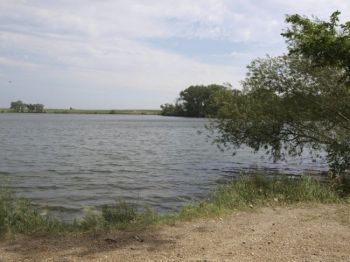
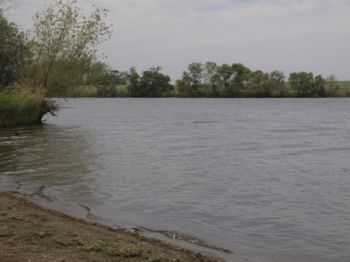
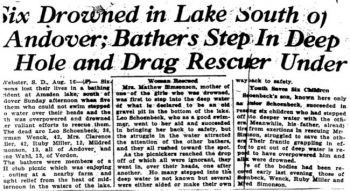
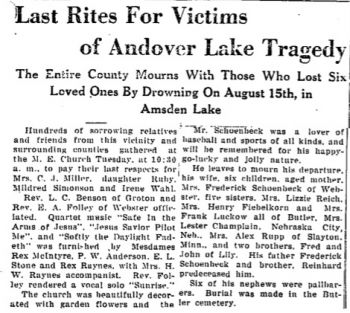
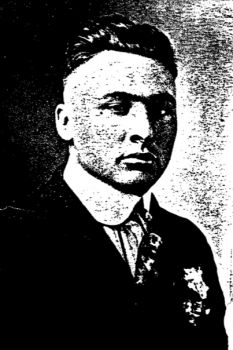
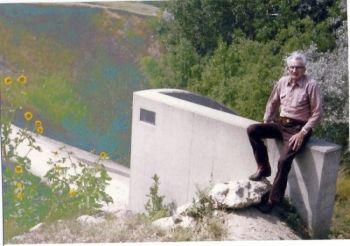




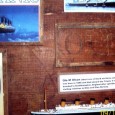
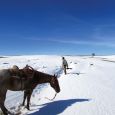


Comments
You did a great job writing this story...
Thanks for the total story.
Lee did a nice job of recording this piece of history.
Carl
That was the 1984 campaign for Day County States Attorney. When I drove farmhouse to farmhouse, the trip through southwest Day County was an education for me, as so many folks like your family, knew my family since the days of statehood. Thank you for reminding me
yes I remember you teaching at Christ the King - I was also your paperboy! I know your brother and see him every once in a while. Lee
Thanks Lee.
flu epidemic my grandfather remarried and had 3 children, Ruby Miller was one of the children that drown.